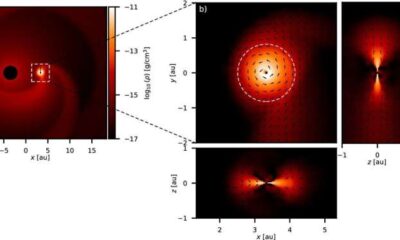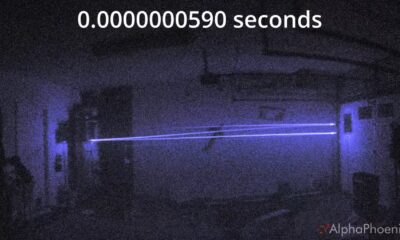Science
ALMA and JWST Uncover Secrets of Star Formation with HH 211

A collaborative study utilizing the Atacama Large Millimeter/submillimeter Array (ALMA) and the James Webb Space Telescope (JWST) has unveiled critical insights into the star formation process through the observation of a protostar known as HH 211. Located approximately 1,000 light-years from Earth in the Perseus constellation, this research clarifies how energetic jets produced by young stars facilitate their growth.
Astronomers have long grappled with the complexities surrounding star formation, a process that occurs in dense clouds of cold gas and dust. As these clouds accumulate mass, they collapse under gravitational forces, leading to the birth of protostars. As they form, these stars generate accretion disks—swirling disks of gas and dust that provide the necessary material for their growth. Yet, if the accretion disk spins too rapidly, this material can struggle to fall toward the star.
Research indicates that protostars emit energetic jets to help expel some of the surrounding material, allowing for smoother accretion. Despite this understanding, observing the jets has posed significant challenges due to their proximity to the protostar, making them difficult to capture with even the most powerful telescopes. Previous theories have suggested that magnetic fields within these systems may play a role in jet ejection.
New Discoveries from ALMA and JWST
In a study published on August 13, 2025, in the journal Scientific Reports, researchers focused on HH 211, a Herbig-Haro object that is only 35,000 years old and contains a central protostar with a mass of merely 0.06 times that of the Sun. The ALMA observations revealed a bright bipolar jet shooting out at speeds of approximately 66 miles per second (or 107 kilometers per second), while also indicating that this jet rotates slowly, possessing a specific angular momentum.
These findings suggest that the bipolar jet effectively removes excess rotational energy, facilitating material’s ability to fall into the star. The researchers calculated that the jet originates from a distance of just 0.02 astronomical units, equivalent to about 1.85 million miles (or 3 million kilometers) from the protostar. This observation aligns with models proposing that magnetic fields can act like a slingshot, propelling gas outward.
The stunning images captured by the JWST showcase the colorful display of the bipolar jet in near-infrared wavelengths. However, the thick cosmic dust surrounding the central region obstructs a clear view of where the jet is generated. By integrating ALMA’s submillimeter data, the researchers were able to reveal the crucial thin region at the center, creating a comprehensive view of the star formation process.
The Significance of the Findings
The merged ALMA and JWST data is groundbreaking, marking the first instance where the launch location of a protostellar jet has been observed. This discovery supports the notion that these jets are vital for the growth of newborn stars, as they effectively remove angular momentum from the accretion disk, enabling easier material accretion onto the star.
The collaboration between ALMA and JWST not only enhances our understanding of star formation but also highlights the importance of interdisciplinary research in unraveling the mysteries of the universe. As astronomers continue to study these phenomena, the insights gained from HH 211 may pave the way for further discoveries in stellar evolution.
For more captivating images and updates on space exploration, readers are encouraged to explore the archives of our Space Photo of the Week.
-

 Science1 month ago
Science1 month agoOhio State Study Uncovers Brain Connectivity and Function Links
-

 Politics2 months ago
Politics2 months agoHamas Chief Stresses Disarmament Tied to Occupation’s End
-

 Science1 month ago
Science1 month agoUniversity of Hawaiʻi Joins $25.6M AI Project for Disaster Monitoring
-

 Entertainment1 month ago
Entertainment1 month agoMegan Thee Stallion Exposes Alleged Online Attack by Bots
-

 Science4 weeks ago
Science4 weeks agoALMA Discovers Companion Orbiting Giant Star π 1 Gruis
-

 Science2 months ago
Science2 months agoResearchers Challenge 200-Year-Old Physics Principle with Atomic Engines
-

 Entertainment1 month ago
Entertainment1 month agoPaloma Elsesser Shines at LA Event with Iconic Slicked-Back Bun
-

 World1 month ago
World1 month agoFDA Unveils Plan to Cut Drug Prices and Boost Biosimilars
-

 Top Stories2 months ago
Top Stories2 months agoFederal Agents Detain Driver in Addison; Protests Erupt Immediately
-

 Business1 month ago
Business1 month agoMotley Fool Wealth Management Reduces Medtronic Holdings by 14.7%
-

 Entertainment1 month ago
Entertainment1 month agoBeloved Artist and Community Leader Gloria Rosencrants Passes Away
-

 Science2 months ago
Science2 months agoInnovator Captures Light at 2 Billion Frames Per Second








